![]()
![]()
![]()
Use LEFT and RIGHT arrow keys to navigate between flashcards;
Use UP and DOWN arrow keys to flip the card;
H to show hint;
A reads text to speech;
95 Cards in this Set
- Front
- Back
- 3rd side (hint)
|
a building column that is shaped like a female figure
|
Caryatid (male: atlantid)
|
|
|
|
in architecture, a sunken panel in a ceiling
|
Coffer
|
|
|
|
a graceful arrangement of the body based on tilted shoulders and hips and bent knees
|
Contrapposto
|
|
|
|
a vault formed by layers of stone that gradually grow closer together as they rise until they eventually meet
|
Corbel Arch
|
|
|
|
a small dome rising over the roof of a building; in architecture, a cupola is achieved by rotating an arch on its axis
|
Cupola
|
|
|
|
a type of construction that uses rough, massive blocks of stone piled one atop the other without mortar. Named after the mythical Cyclops
|
Cyclopean masonry
|
|
|
|
a visual effect in which an object is shortened and turned deeper into the picture plane to give the effect of receding in space
|
Foreshortening
|
|
|
|
a painting technique that involves applying water-based paint onto a freshly plastered wall. The paint forms a bond with the plaster that is durable and long-lasting.
|
Fresco
|
|
|
|
an archaic Greek sculpture of a standing youth
|
Kouros (female: kore)
|
|
|
|
a circular window in a church (Pantheon), or a rounding opening at the top of a dome
|
Oculus
|
|
|
|
the triangular top of a temple that contains sculpture
|
Pediment
|
|
|
|
French, “to push back;” a type of metal relief sculpture in which the back side of a plate is hammered to form a raised relief on the front
|
Repoussé
|
|
|
|
an ancient Greek circular shrine
|
Tholos
|
|
|
|
a roof constructed with arches. When arch is extended in space, forming a tunnel, it is called a barrel vault. When two barrel vaults intersect at right angles, it is called a groin vault
|
Vault
|
|
|
|
sculptures from the Roman Republic characterized by extreme realism of facial features.
|
Veristic
|
|
|
|
1. Unafraid of nudity
2. Perfection of the human body 3. Large Greek marble sculptures: cut away from the stone 4. Large-scale bronze works were treasured 5. Greek art in the Classical and Hellenistic periods used contrapposto |
Greek Sculpture Innovation
|
|
|
|
1. Temples designed to be the earthly homes of the gods
2. Preferred limited access to the deity; doors were removed from public view 3. Front and back of Greek temples look almost identical; only the sculptural ornament is different 4. Temple complexes were placed on a high hill or acropolis 5. Propylaea: gateways / entrance into the complex 6. Developed: tholos and caryatids 7. Build stoas (shopping centers) and theaters |
Greek Architecture Innovation
|
|
|
|
1. Professional pottery had been practiced in Greece from its origins in Aegean society throughout the entire span of the Greek period
2. Some vessels were everyday items, other served as tomb monuments 3. Form followed function in Greek pottery Painters wrote inscriptions that were sometimes literally addressed to the viewer of the pot, i.e. “I greet you” 4. Inscriptions could explain the narrative scene represented, or identify people or objects 5. The underside of the vases usually indicated the selling transaction of the pot |
Greek Pottery Innovation
|
|
|
|
1. Exemplifies complex linear decoration and reduction of body parts to simple geometric shapes
2. Produce many small figurines of wood, ivory, clay and especially cast bronze |
Greek Geometric 900-700BCE Characteristic
|
|
|
|
1. Temples: (1) rectangular and organized on an inventive, although rigid, set of geometric principles; (2) built with the post-and-lintel system; (3) the columns never too widely set apart
2. Pediments: project over the top of the columns; contained sculpture representing the heroic deeds of the god or goddess housed inside 3. Cornice: separates the upper and the lower parts of a Greek temple Doors were set back from the façade, sometimes by two rows of columns, so that little light could enter 4. Generally windowless |
Greek Geometric 900-700 BCE Architecture Characteristic
|
|
|
|
1. Earliest pots are largely composed of horizontal lines with minimal figures
2. Characterized by linear designs and abstract patterns |
Greek Geometric 900-700 BCE Pottery Characteristic
|
|
|
|
1. There is much influence from the Egyptian and Mesopotamian art
2. Eastern floral motifs and exotic animals take their place next to the geometric bands of ornament |
Greek Orientalizing 700-600 BCE Pottery Characteristic
|
|
|
|
1. Marble (stone of choice), bronze, limestone, terra cotta, wood, gold – even iron
2. Sculpture was often painted; backgrounds were highlighted in red; lips, eyes, hair and drapery were routinely painted 3. Often had metallic accessories: thunderbolts, harps and various other attributes 4. Bronze sculpture: hallow; eyes were inlaid with stone or glass, and lips, nipples and teeth of copper or silver highlights 5. Kouros and kore figures: grave monuments from Greek temples 6. Known for its bolt upright figures and animating smiles |
Greek Archaic 600-480 BCE Sculpture Characteristic
|
|
|
|
1. Artists painted in a style called black figure, which emphasized large figures drawn in black on the red natural surface of the clay. 2. Details were later added in highlighting colors
3. Bright glazing of Greek pottery gives the surface a lustrous shine 4. Red figure vases were introduced; in effect, they are the reversal of black figure style pots 5. Archaic pottery has the same stiffness and monumentality of Archaic sculpture |
Greek Archaic 600-480 BCE Pottery Characteristic
|
|
|
|
1. Use of contrapposto
2. Forms became highly idealized. 3. Bodies depicted in heroic form: heads are one-seventh of the body; heavy musculature |
Greek Classical 480-400 Sculpture Characteristic
|
|
|
|
Achievements in Classical sculpture were paralleled in pottery
|
Greek Classical 480-400 Pottery Characteristic
|
|
|
|
1. 4th Century BCE
Gods were sculpted in a more humanized way 2. Heads that are one-eight of the body and a sensuous S-curve to the frame |
Greek Late Classical 400-320 Sculpture
|
|
|
|
1. Realistic modeling; show more movement
2. Figures have great variety of expression from sadness to joy 3. Themes: childhood, old age, despair, anger and drunkenness 4. Sculptors carve with greater flexibility, employing negative space more freely 5. The viewer is meant to walk around a Hellenistic sculpture |
Greek Helenistic 320-30 Sculpture Characteristic
|
|
|
|
Dynamic movements of the Hellenistic period reflected in Greek Hellenistic pottery
|
Greek Helenistic 320-30 Pottery Characteristic
|
|
|
|
1. Romans were master builders
2. Improved on architectural techniques: post and lintel, arches, vault (barrel, groin), coffers, 3. Forged great road and massive aqueducts as an efficient way of connecting their empire and making cities livable 4. Temples were hymns to the gods and symbols of civic pride 5. Arenas awed spectators both by their size and their engineering genius 6. Used concrete in constructing many of their oversized buildings 7. All concrete buildings were concealed with another material, like marble, which appeared more attractive to their eye |
Roman Architecture Innovation
|
|
|
|
1. Exteriors of Roman houses had few windows
2. Single entrance was usually flanked by stores that faced the street 3. Atrium, impluvium, cubicula, peristyle 4. Grander Roman buildings used concrete, arches and various kind of vaulting techniques to achieve grand and spacious effects 5. Forum and stoas |
Roman Architecture Characteristic
|
|
|
|
1. Interior wall paintings were frescoed with mythological scenes, landscapes, and city plazas
2. Mosaics were favorite floor directions―stone kept feet cool in summer 3. Encaustics from Egypt provided lively individual portraits of the deceased 4. Murals were painted with some knowledge of: linear perspective, orthogonals, atmospheric perspective 5. Figures were painted in foreshortening |
Roman Painting Innovation
|
|
|
|
Characterized by painted rectangular squares meant to resemble marble facing
|
Roman Painting Characteric Pompeian 1st
|
|
|
|
Had large mythological scenes and/or landscapes dominating that wall surface
Painted stucco decoration of the First Style appears beneath in horizontal bands |
Roman Painting Characteristic Pompeian 2nd
|
|
|
|
Characterized by small scenes set in a field of color and framed by delicate columns of tracery
|
Roman Painting Characteristic Pompeian 3rd
|
|
|
|
Combined elements from the previous three: painted marble of the First Style is at the base, large scenes of the Second Style and delicate small scenes of the Third Style are intricately interwoven
|
Roman Painting Characteristic Pompeian 4th
|
|
|
|
1. Erected commemorative arches to celebrate military victories
2. Sculptures were applied to the surface of the arches to animate the architecture as well as to recount the story of Roman victories; a combination of painted relief and free-standing works was integrated into a coherent didactic program 3. Hollowed-out column with banded narrative relief sculptures spiraling around the exterior |
Roman Sculpture Innovation
|
|
|
|
1. Veristic sculptures: Republican busts of noblemen; strikingly and unflatteringly realistic
May have been a form of idealization: Republicans valued virtues such wisdom, determination, and experience 2. Full-length statues concentrate on the heads, some of which are removed from one work and place on another. 3. Bodies were occasionally classically idealized, symbolizing valor and strength 4. Figures can sometimes be seen holding busts of their ancestors in their hands (patrician heritage) |
Roman Sculpture Characteristic Republican
|
|
|
|
Emperors, whose divinity descended from the gods themselves, were portrayed differently than noblemen or senators
Sculptors adopted the contrapposto, ideal proportions, and heroic poses of Greek statuary Forms became less individualized, iconography more associated with the divine |
Roman Sculpture Characteristic Imperial
|
|
|
|
1. Transitions into the Late Imperial style reflected the dissolution and anarchy of the Roman state
2. Compositions are marked by figures that lack individuality and crowded tightly together 3. Everything is pushed forward on the pictures plane, as depth and recession were rejected 4. Proportions are truncated; bodies are almost lifeless behind masking drapery 5. Emperors are increasingly represented as military rather than civilian rulers |
Roman Sculpture Characteristic Late Imperial
|
|
|
|
Two periods in oldest art
|
Paleolitic & Neolithic
|
|
|
|
–people cultivated the earth and
raised livestock – people lived in organized settlements, divided labor into occupations, constructed the first homes |
Paleolithic (Old stone age)
|
|
|
|
–people cultivated the earth and
raised livestock – people lived in organized settlements, divided labor into occupations, constructed the first homes |
Neolithic (New Stone Age)
|
|
|
|
Buildings such as Stonehenge show
the ability of prehistoric people to build elaborate religious structures using? |
the post-and-lintel system of construction
|
|
|
|
Mesopotamia
|
• Tigris and Euphrates
• Agriculture: basis of wealth • Kingship: government • Religion: central role in government and daily life • Few natural defenses • Repeated invasions and internal conflicts • Cuneiform – Latin “wedge-shaped;” named after the shape of the marks made by the stylus |
|
|
|
means a circle formed by stones or wooden posts, often surrounded by a ditch with built-up embankments
|
Henge
|
|
|
|
Symbols evolved from pictures into phonograms thus becoming a true writing system.
|
Cuneiform
|
|
|
|
Egypt
|
• Nile
• Agricultures: basis of wealth • Kingship: government • Religion: central role in government and daily life • Mountains and deserts • Remained a unified state for some 3,000 years • Hieroglyphs – earliest Egyptian writing system which employed symbols |
|
|
|
Used in combinations, such phonogramic hieroglyphs were especially useful in rendering foreign names.
|
Hieroglyphs
|
|
|
|
Egyptian art spans a?
|
3,000-year
history |
|
|
|
show unyielding
stance and formidable expression |
Old kingdom figures
|
|
|
|
• have more relaxed figures and emotional faces (Mentihotep II) |
Middle Kingdom works
|
|
|
|
is characterized by
rounded and elongated figures that betray an intimacy hitherto unknown |
• New Kingdom
|
|
|
|
– history’s first recorded
artist; royal builder for King Djoser; ordained high priests of Ptah |
Imhotep
|
|
|
|
– built as part of great
complexes; known for their solid surfaces and their monumental scale; made from stone blocks and built without mortar; sides oriented to the four cardinal points of the compass |
Pyramid
|
|
|
|
– “city of the dead,” a large
burial area |
Necropolis
|
|
|
|
– “bench,” a low, flat-roofed
Egyptian tomb with sides sloping down to the ground |
Mastaba
|
|
|
|
The earliest surviving works of art are
|
cave paintings and portable sculptures of humans or animals. |
|
|
|
_ is known about the original
intention |
Little
|
|
|
|
The Ancient Near East brought about _. Combined with
writing, Mesopotamian objects give us the first systematic record of human development. |
the birth of art in the service of the
state and religion |
|
|
|
Ancient Near Eastern buildings were
created for _, as were ziggurats, or the state, as were the palaces. They were built of mud-brick, and were either painted or faced with tile or stone. |
religion
|
|
|
|
• Large stelai commemorating the
achievements of ancient rulers were erected throughout? |
Mesopotamia
|
|
|
|
_ figures that are usually
hybrids of men and animals protected the entrances to important sites. |
Guardian
|
|
|
|
_ are among the
first organized narrative works of art in history. |
Assyrian lion reliefs
|
|
|
|
• Kings realized the capacity of the
artists and how their works could aggrandize the image of the kings, etc. • This was the start of one of the most symbiotic relationship in art history between patron and artist. |
Patronage and Artistic Life
|
|
|
|
Buildings were mostly built from?
|
baked mud (constructed to live,
govern and worship in). |
|
|
|
– stepped pyramidal
structures with a temple or shrine on top |
Ziggurat
|
|
|
|
Depicted clothed humans with
anatomical precision. Figures are actively engaged in doing something: |
hunting, praying, performing a ritual.
|
|
|
|
_ were retained in
cities as a sign of their permanence. Large-scale relief sculptures were carved into stone surfaces of palace interiors. |
Monumental objects
|
|
|
|
– a
round piece of carved stone that when rolled onto clay produces an image |
Invention of the Cylinder Seal
|
|
|
|
Began a popular ancient tradition of
representing |
animals with human
characteristics and emotions |
|
|
|
Elaborate funerary practices led to the
|
erection of mastabas, pyramids and
rock-cut tombs in sacred imperial precincts throughout Egypt |
|
|
|
Egyptian figures generally have
|
broad
frontal shoulders and profiled heads, torsos, and legs |
|
|
|
Most Egyptian temples have?
|
astronomical orientation
|
|
|
|
• Columns in the New Kingdom were
based on |
plant shapes (lotus, palm,
papyrus) |
|
|
|
Men are taller than women and are
painted |
ruddy brown or red
|
|
|
|
Women are shorter and are painted
with a |
yellowish tinge
|
|
|
|
• Persons of lesser social rank are
represented more |
naturalistically
|
|
|
|
• Conventions of Egyptian Painting and
relief sculpture (dignitaries): |
1) heads are shown in profile to
best capture the subject’s identifying feature 2) eyes are rendered in frontal view 3) shoulders are represented frontally 4) hips, legs and feet are drawn in profile 5) successful men and women are represented in a calm, rational manner |
|
|
|
Figures rest on a _ at the
front of the picture plane; when figures are place on a line above, they are thought to be _ |
horizon line; receding into the
distance |
|
|
|
Central to ancient Egyptian belief was
the idea that every human being had a life force – the _ or spirit. The _ lived on after the death of the body, forever engaged in the activities it had enjoyed during his earthly existence. |
Ka
|
|
|
|
Characteristics of sculptures:
|
1) lifelike figures 2) rigidly frontal, simple conceptions 3) rectilinear and block-like 4) figures mostly stands in a typical Egyptian balanced pose with one foot in front of the other, arms straight on the side, fist clenched |
|
|
|
Relief sculptures
|
1) followed the conventions of painting 2) outdoor: cut into the rock so that shadows showed up more dramatically 3) indoors: raised from the surface for visibility in the dark |
|
|
|
Prehistoric Time Table BCE
|
Geometric 900-700
Orientalizing 700-600 Archaic 600-480 Classical 480-400 Late Classical 400-320 Hellenistic 320-30 |
|
|
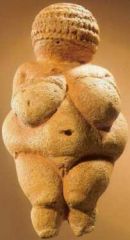
|
Oldest Art
Austria 22000-21000 BCE Lime Stone 11cm |
Woman from Willendorf
|
|
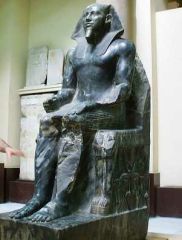
|
Egypt
From Giza Dynasty 4 2544 BCE Dionte, Height 1.68m -represents the ruler enthroned & protected by the falcon god Horus |
Khafre
|
|
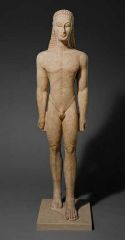
|
Archaic
600 BCE Marble 1.93m |
Kourus
|
|
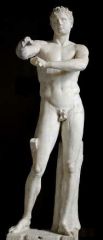
|
late classical
330 BCE marble copy from a bronze original 8 heads |
scraper
|
|
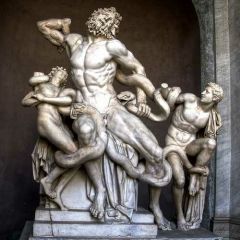
|
Hellenistic
Marble 2.44m |
Laocoon and his sons
|
|
|
Mesopotamian Time Table BCE
|
3500-2340 Sumerian Iraq
2180-2340 Akkadian Iraq 2150-2000 Neo Sumerian Iraq 1792-1750 Babylonian Iraq 612-539 Neo Babylonian Iraq 559-331 Persian Iran 1600-1200 Hittite Turkey |
|
|
|
Egypt Time Table
|
2575-2134 Old Kingdom
2040-1620 Middle Kingdom 1550-1070 New Kingdom |
|
|
|
Aegean Time Table BCE
|
3000-1600 Cycladic Cycladic
1900-1375 Minoan Crete 1400- 1100 Mycenaean Greece |
|
|
|
The Cycladic civilization of the Greek
islands produced |
stylized statuettes of nude
standing females and nude males playing musical instruments. |
|
|
|
The Minoans from the island of Crete built
|
mixed-use palaces with complex ground
plans. |
|
|
|
Cyclopean masonry and corbelled arches
are key characteristics of . |
Mycenaean
architecture |
|

